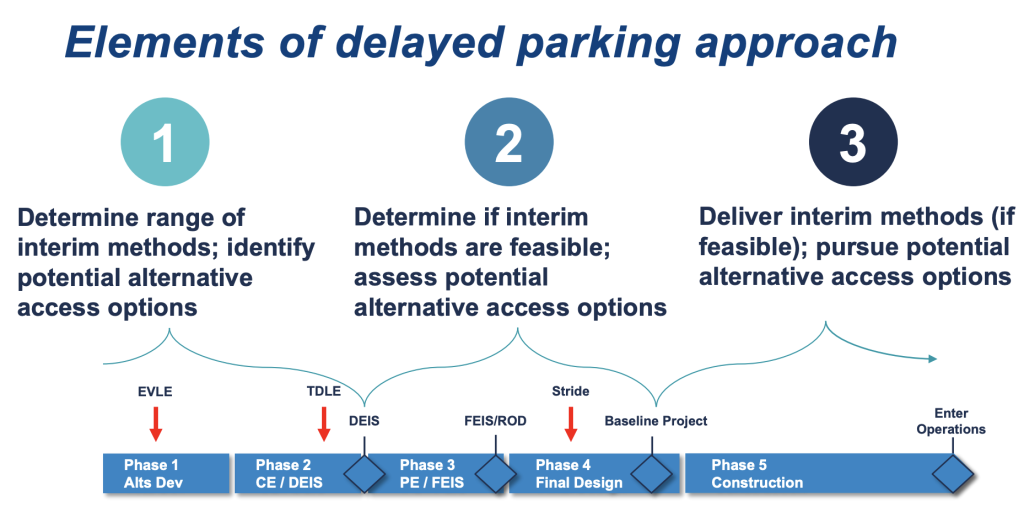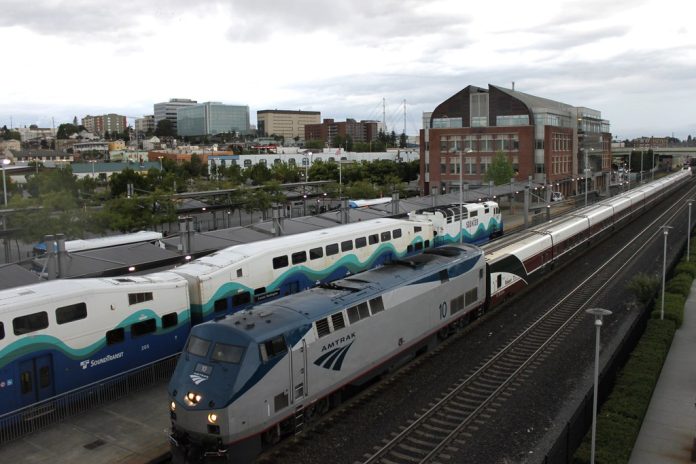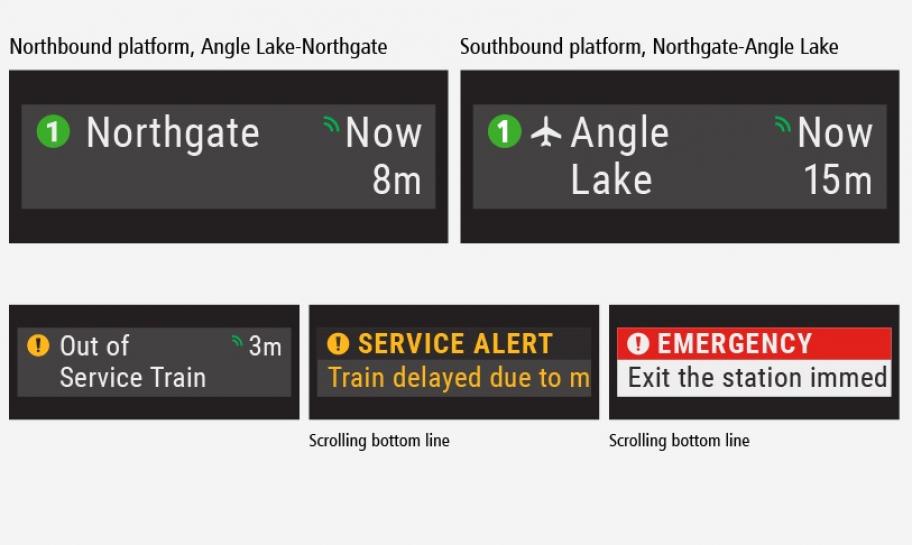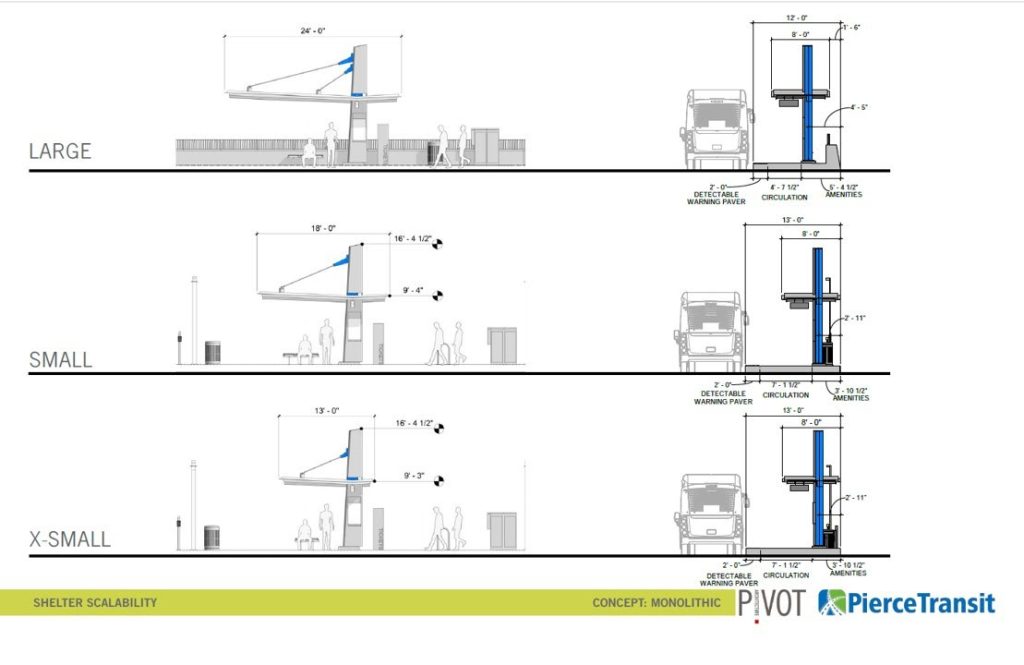This week’s Transpo Notes roundup touches on the status of Sound Transit’s new real-time arrival and digital ad signs, Amtrak Cascades’ northern service, Pierce Transit’s Stream bus rapid transit project, Sound Transit in-person board meetings, Community Transit’s new microtransit service and real-time arrival signs, and Sound Transit’s system access strategies.
Sound Transit’s new real-time arrival and digital ad signs are delayed
Sound Transit is plagued with delays across many programs and that applies to deployment of new passenger information systems and digital advertising signs. Originally, those systems and signs were supposed to be operational this spring, but the agency now says that their deployment has slipped to the fall.

Last fall, we reported that about eight digital advertising signs would begin appearing in Link stations this spring as part of the first phase of a revenue-generating and placemaking opportunity. Sound Transit, however, now expects to see the first screens being installed in September at either Westlake or University Street Stations. Work on determining screen locations and station engineering analysis has been completed, but detailed engineering for installation is still in progress.
Most riders, however, will be much more concerned with the delay in launching the new passenger information management system (PIMS), which controls digital screens at Link stations and are supposed to provide real-time arrival information. Sound Transit had hoped to roll out the new system in June, but the launch time is now sometime in the fall.
A frequent question among riders is why Sound Transit won’t just turn on the system they do have to provide real-time arrival information in the interim. The agency contends that it wouldn’t meet their standards for reliability and quality. “When we turned off Link arrival predictions on the legacy passenger information system in December we believed that we would begin launching our new [PIMS] by June,” John Gallagher, a Sound Transit spokesperson, shared in an email. “However, during recent testing we realized that the system was not yet up to the high standards we have set for reliability and accuracy of our new system… We know it’s frustrating to riders not to have arrival predictions on Link, but unfortunately the legacy system we’d relied on since Link was introduced in 2009 was displaying arrival predictions that were inaccurate and that problem grew worse with the introduction of Northgate Link last fall.”
At times, the screens would display some very extraordinary predictions for next trips, such 50 or 75 minutes. Seasoned riders might know to ignore that, but others might not and abandon using the train altogether.
When the new PIMS does finally launch, it will offer a variety of new features that will be pushed to screens and transit apps, such as real-time arrival predictions (including for unscheduled trains), service change information, re-route information, and a GTFS-RT feed supporting OneBusAway. Sound Transit has also promised that “the next software release will introduce further integrations and allow us to provide elevator/escalator service outage information,” which is expected to be launched in Spring 2023. Other enhancements to the system will include better onboard GPS for Link vehicles that improve real-time arrival predictions and add real-time vehicle load data.
Additionally, legacy screens will be replaced after PIMS has launched. Sound Transit will complete this work on a station-by-station basis over the course of four or five months. That means replacement should be completed by the end of Spring 2023.
Amtrak Cascades northern service further delayed
Restoration of the Seattle-to-Vancouver, British Columbia Amtrak Cascades service will be further delayed, the Washington State Department of Transportation (WSDOT) said on Friday. Amtrak told both state transportation departments in Washington and Oregon that service restoration had been pushed back to late this year due to staffing shortages. The national intercity passenger rail provider has been slowly restoring service over the past year as it has struggled with the impacts of the Great Resignation.
The route operated with two daily roundtrips prior to the pandemic and carried about 290,000 passengers per year, but the pandemic halted cross-border non-essential travel in March 2020. That restriction was only lifted in November 2021 when bus-based service was restored. Amtrak Cascades has been operating special Amtrak Thruway buses since December 2021, but the agency had been hopeful that training exercises in the winter or spring would bring restored train service. That appears to have faltered.
WSDOT issued a stern statement on Friday afternoon and appears to have put pressure on Amtrak to restore service sooner. “WSDOT and ODOT (Oregon Department of Transportation) expressed extreme dissatisfaction with this plan and urged Amtrak to at least begin offering service a few days a week on an interim basis until full service can resume in December 2022,” the statement read. “Amtrak noted it is committed to an earlier start date if employee resources allow.”
Whether or not the December target will be realized is anyone’s guess, but WSDOT noted that there are numerous staffing needs and that there has been some forward progress in hiring. “Several staff positions need to be filled including conductors, on-board service staff, and mechanics,” the agency said. “Progress is being made in recruiting necessary staff; however, once hired, they must complete extensive training programs before starting their jobs.”
On a positive note, Amtrak announced earlier this week that Empire Builder service, which runs between Seattle/Portland and Chicago, will see seven-day-a-week service return on May 23rd. The service had been running only five day a week since last fall.
Pierce Transit delays and downgrades its first bus rapid transit line
Last week, Pierce Transit quietly announced further changes and severe delays to the agency’s planned and beleaguered Stream bus rapid transit line. The soonest the line could start service is now early 2027.
Pierce Transit blames the pandemic, as well as the design and permitting process, for the additional four-year delay. The line was supposed to open in the next two years, but now construction won’t even start until late 2024 at the earliest. Additional design changes, dubbed “value engineering,” will further downgrade the project quality, too. The agency says that these changes have been precipitated by inflation, which has driven project costs higher.
Design changes are coming in many ways, but probably the most concerning is the design of transit operations. Pierce Transit announced in a single sentence via a newsletter that “some sections of the corridor that were previously identified for median, transit-only lanes will now be designated curbside in mixed-use traffic, much like Route 1 runs today.” That means that buses will get stuck in car traffic even more frequently along the corridor than was unveiled last year.
Over the past few years, similar value engineering exercises have reduced the project quality, usually at every update period. Last year, Pierce Transit had landed at only 4.5 miles of median exclusive lanes out of a 14.4-mile corridor. That’s down from over six miles planned in 2019. The new revelations would suggest that hardly any exclusive lane-mileage will now exist on the line, which really begs the question of how this level of service can even be considered bus rapid transit. But beyond the exclusive lane downgrades, Pierce Transit is also reducing the quality of some stations by narrowing canopies and platforms (justified by projected ridership levels) and pulling back other right-of-way changes.
Sound Transit board debates in-person meetings
Policymakers at the Sound Transit Board of Directors earlier this month weighed in on the future of in-person board meetings. Views on in-person meetings were somewhat divergent.
Board Chair Kent Keel said that June will see the return of in-person board meetings now that Governor Jay Inslee’s order to go remote is ending. Keel said that only about a quarter of members on a committee or at full board members could be remote according to policy. Everett Mayor Cassie Franklin noted that a trek into Seattle would take a good chunk out of her day, but suggested that important meetings be mostly in-person. Snohomish County Executive Dave Somers largely echoed her sentiment with what he claimed was many hours of “dead time” — which seems a bit dramatic since one can often work productively while onboard transit. Additionally, Auburn Mayor Nancy Bacchus said that she’s taken on so meetings and responsibilities in the past two years that traveling could impact those obligations.
King County Claudia Balducci acknowledged the distances that members outside of King County would need to travel for these meetings. She said that other boards that she is on, like at the Puget Sound Regional Council, were still planning to be remote. Balducci also said that hybrid remote meetings were legal as long as a governing board still provided options for in-person attendance of the public and comment. Seattle Mayor Bruce Harrell suggested that increasing the percentage of remote attendance should be considered. Keel, however, said that by doing that it could change the dynamic of the board and how they interact.
Changes could be on the way, but the full board would have to vote on changes and passage would require a supermajority.
Community Transit commissions new real-time arrival signs and microtransit service
Community Transit is planning to procure new real-time information systems for its Swift bus rapid transit fleet. According to an agency report, “existing technology is at end of life, difficult to source replacements, and supports only a single line of information, limiting its ability to display key information to riders.” Community Transit is hoping to purchase more modern technology, allowing “variable messaging, system integrations, open communication and data support, and robust, full-color content management.” Specifically, the agency wants its new system to provide “real-time bus departures, and in the future will include real- time service alerts (including delays, cancellations, and detours), campaign-level communications (health/safety reminders, upcoming changes to service, etc.), and schedule information.”
Earlier this month, the agency authorized a procurement order with Message Point Media of Alabama to replace signage on the Swift Blue Line and initial signage on the Swift Orange Line. The budget for the project is $5 million.
Additionally, Community Transit has authorized just over $1 million to contract with Medstar Transportation for microtransit services over a 12-month period. This will allow a microtransit pilot in Lynnwood to proceed in the next year.
Sound Transit offers vague outline for system access and alternatives for delayed parking projects

Also earlier this month, Sound Transit staff briefed the board system access policies and on interim system access strategies for Sound Transit 3 high capacity transit projects with delayed parking project components. Boardmembers were very curious about how station access and parking might be addressed in the years ahead, and Seattle Mayor Bruce Harrell even brought up how station facilities might be better utilized for other uses, such commercial vendors.
Generally speaking, there wasn’t much meat in the presentations on actually strategies that might be employed beyond the possibility of using interim surface parking on surplus sites and “alternative strategies.” The presentation was more concerned about the process of deriving and implementing strategies. King County Councilmember Claudia Balducci picked up on this in her comments asking what boardmembers really could expect solutions at seven of the 13 locations with delayed parking projects, but there weren’t really any illuminating answers to her question.
In her remarks, Balducci said that given when the parking projects are constructed (generally in the mid-2030s to mid-2040s), the station areas could already become dense enough that building parking garages might not be the best use of valuable land. She suggested leasing land temporarily for parking until a higher better use comes along, microtransit (e.g., Via to Transit), and designing parking garages in a flexible way for future conversion to other uses.
Regarding the system access discussion, Mayor Harrell mentioned programming stations with “revenue opportunities” like coffee stands. “I’m always trying to find small business opportunities wherever we can given the portfolio of assets that we have, and sometimes I think we’re not taking full advantage of that,” he said. Staff said that they are looking at activation opportunities at Mount Baker Station, for instance, with food trucks (the station has a very large plaza right below the station platforms).
Stephen is a professional urban planner in Puget Sound with a passion for sustainable, livable, and diverse cities. He is especially interested in how policies, regulations, and programs can promote positive outcomes for communities. With stints in great cities like Bellingham and Cork, Stephen currently lives in Seattle. He primarily covers land use and transportation issues and has been with The Urbanist since 2014.





